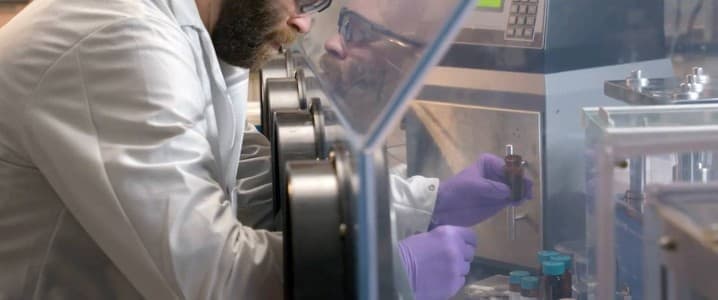Worcester Polytechnic Institute’s Xiaowei Teng, the James H. Manning professor of Chemical Engineering at WPI, has discovered a new redox chemistry empowered by chloride ions. The development of using seawater sourced chloride batteries with sodium potassium and zinc have all been promising contenders for lithium’s place in rechargeable batteries of the future. Now the researchers have added an unusual and more abundant competitor to the mix: chloride, the richest negatively charged ions in seawater. The study paper has been published in the journal Chemistry of Materials.
Modern lithium-ion batteries used in various applications, including electric vehicles, can be problematic for grid storage, given their high cost and reliance on critical materials, such as cobalt, nickel, and lithium, as well as their limited geographical availability. For example, six countries own over 85% of lithium reserves on the land.
The new battery technology was highlighted on the supplementary front cover of the American Chemical Society journal Chemistry of Materials. Image Credit: Chemistry of Materials, American Chemical Society. Click either the press release or the study paper links for more information.
Teng and his research collaborators – Heath Turner, professor of Chemical and Biological Engineering at the University of Alabama, and Lihua Zhang, Milinda Abeykoon, Gihan Kwon, Daniel Olds, all research scientists at Brookhaven National Laboratory in New York – went beyond the limits of current green battery technology by leveraging chloride ions to empower redox chemistry of iron oxide battery materials.
Teng and his colleagues report on the new battery chemistry in “Chloride-Insertion Enhances the Electrochemical Oxidation of Iron Hydroxide Double Layer Hydroxide into Oxyhydroxide in Alkaline Iron Batteries,” published in the American Chemical Society journal Chemistry of Materials was also highlighted in the supplementary front cover.
This study revealed that chloride ion insertion into Fe(OH)2 layered double hydroxide formed a Green Rust intermediate crystalline material, which assisted a one-charge transfer Fe(OH)2/FeOOH conversion reaction and improved cycling stability. This new iron redox chemistry was discovered and examined in the WPI lab.
Teng and his graduate student Sathya Narayanan Jagadeesan, who is the leading author of the article, further traveled to Department of Energy User Facilities at Brookhaven National Laboratory to conduct experiments to validate the results using operandosynchrotron X-ray diffraction and high-resolution elementary mapping.
Then Teng and his WPI team made an aqueous battery, a small lab-scale prototype that operated in the water-based electrolyte, using electrodes made mostly from abundant elements such as iron oxides and hydroxides. While the team hasn’t calculated the cost, the use of earth-abundant materials should tip the scale in their favor, Teng noted.
Related: Higher Oil Prices Could Spark A Fresh Wave Of Inflation
The U.S. produces over 15 million tons of scrap iron wastes that are not recycled each year, many of which exist in the form of rust. Therefore, the reported rechargeable alkaline iron battery chemistry helps repurpose the iron rust waste materials for modern energy storage.
The research was funded by the National Science Foundation and the Department of Energy (DOE).
***
More battery chemistries are always welcome. While there aren’t all that many in the market now, we need to keep in mind that good chemistries have to mature, get innovated, go through the trials of millions of users and get refined. Then in a decade or two the chemistry might be prime time ready.
Everyone seems to think lithium ion is the “best” – unless you are trying to start a car on a cold day. As experience and the refinement gets applied most any use will find there is likely a very good battery chemistry for the cost.
Today lithium ion looks the “best”. But look more closely and $20+ grand for an EV battery set might not be the “best”.
Every new battery idea is very welcome indeed. Prices simply have to come down.
By Brian Westenhaus via New Energy and Fuel
More Top Reads From Oilprice.com:
- Oil Soars Above $90 As Saudi Arabia Extends Deep Output Cuts
- China’s Influence In Oil Markets Grows With BRICS Expansion
- From Boom To Gloom: China's Economic Momentum Dips


















